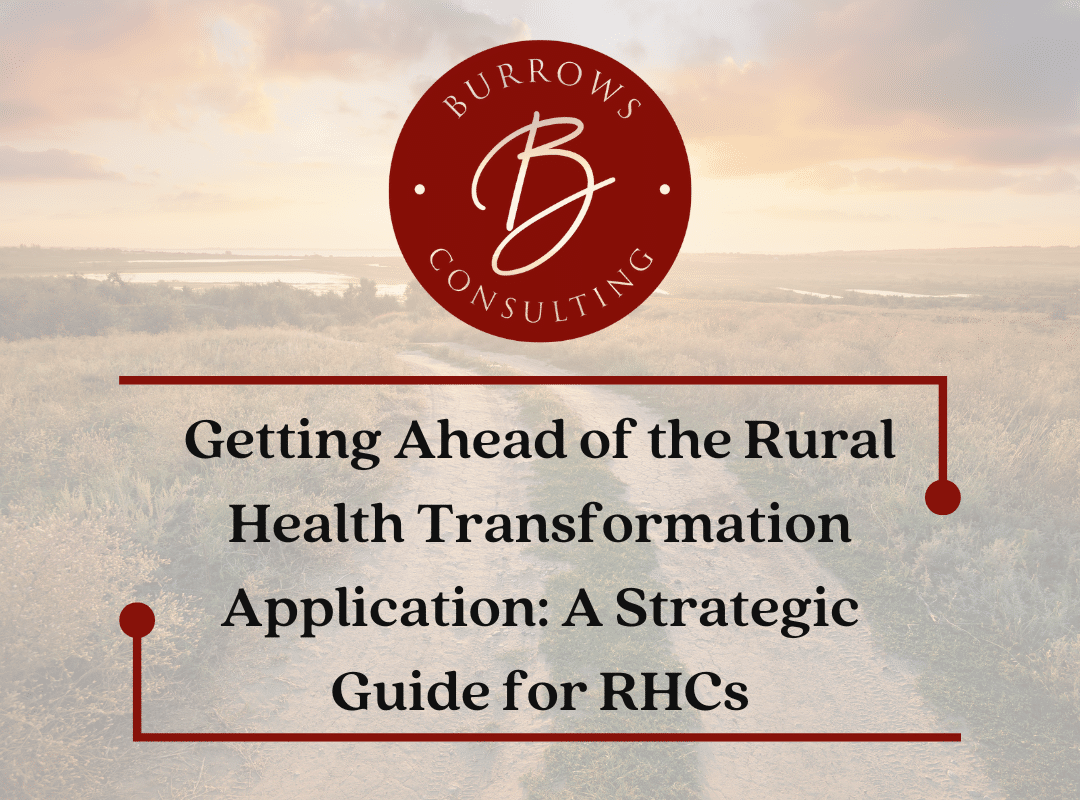By Melissa Jones, CRHCP | Burrows Consulting
The official Notice of Funding Opportunity (NOFO) for the Rural Health Transformation Program is expected later in 2025. However, with Congress already outlining key components of the program, Rural Health Clinics (RHCs) have a unique opportunity to prepare early, align with their state’s planning efforts, and position themselves as key players in this once-in-a-generation investment in rural healthcare.
What We Know So Far
State Applications Due December 31, 2025
Each state must submit a Rural Health Transformation Plan, detailing how funds will be used and the outcomes they aim to achieve.
Funding Structure
Total funding: $10 billion annually from 2026 to 2030
- 50% distributed equally among approved states
- 50% distributed based on rural population, number of rural facilities, and hospital status
Eligible Providers Included in the Formula
When allocating funds, CMS must consider the presence of:
- Rural Health Clinics (RHCs)
- Critical Access Hospitals (CAHs)
- Federally Qualified Health Centers (FQHCs)
- Rural Emergency Hospitals
- Mental Health Centers
- Opioid Treatment Programs
- Other rural health providers
How RHCs Can Strengthen State Plans
To secure funding and support transformation efforts, RHCs should submit SMART-aligned strategies (Specific, Measurable, Achievable, Relevant, Time-bound). Here are examples of how your clinic can align with CMS and state goals:
1. Improve Access to Care
- Set up mobile screening clinics or rotating care teams in remote communities
- Host community health fairs that offer free screenings and telehealth consults
- Open weekend or after-hours clinics for working families and uninsured patients
2. Strengthen Health Outcomes
- Launch chronic care management programs (e.g., diabetes, hypertension) with care coordinators
- Implement remote patient monitoring tied to telehealth visits
- Track performance goals such as reducing A1c levels or hospital readmissions
3. Foster Rural Care Partnerships
- Create referral alliances with regional hospitals for specialty care via telehealth
- Partner with schools, food banks, and social service agencies to address social determinants of health
- Collaborate with behavioral health providers to co-locate services or provide telepsychiatry clinics
4. Enhance Technology Utilization
- Expand telehealth offerings and include platform costs in funding requests
- Upgrade EHR tools to enable interoperability with hospitals and public health agencies
- Invest in patient portals, remote monitoring tools, and AI-powered care coordination support
5. Drive Rural Economic Opportunity
- Use funds to recruit rural-focused providers with five-year service agreements
- Develop internships or workforce pipelines through local schools and AHECs
- Modernize facilities by expanding exam space, upgrading diagnostic tools, or improving infrastructure
How This Shapes Rural Health for the Next Decade
If states incorporate these ideas into their funding plans, rural healthcare could see significant transformation:
- Increased access and reduced travel burden for patients
- Better chronic disease outcomes through real-time monitoring
- Stronger care networks that integrate social and behavioral services
- Tech-enhanced care that reaches beyond clinic walls
- A revitalized rural healthcare workforce with economic benefits for communities
Ultimately, the transformation plan offers a path to a value-based, community-aligned model of care, with RHCs at the center of delivery and coordination.
What You Can Do Today
RHCs have a unique window to shape how this funding will be used. Start by:
- Reaching out to your State Medicaid Agency or Office of Rural Health to request participation in advisory boards
- Sharing your clinic’s strengths in telehealth, chronic care, or partnerships supported by real data
- Proposing specific uses of funds, such as expanding remote monitoring, hiring patient navigators, or facility modernization
- Collaborating with other rural providers to submit joint recommendations or planning proposals
The Bottom Line
Although the formal application process has not yet started, the groundwork you lay now through data, partnerships, and outreach can directly influence how your state prioritizes and distributes funding. This is a once-in-a-decade opportunity to shape the future of rural healthcare, and RHCs are well-positioned to lead the way.
If your clinic needs help identifying opportunities, preparing your strategy, or collaborating with your state, Burrows Consulting can help. We have deep experience working with RHCs and state agencies to turn ideas into funding-ready plans.

0 comments to " Getting Ahead of the Rural Health Transformation Application:A Strategic Guide for RHCs "